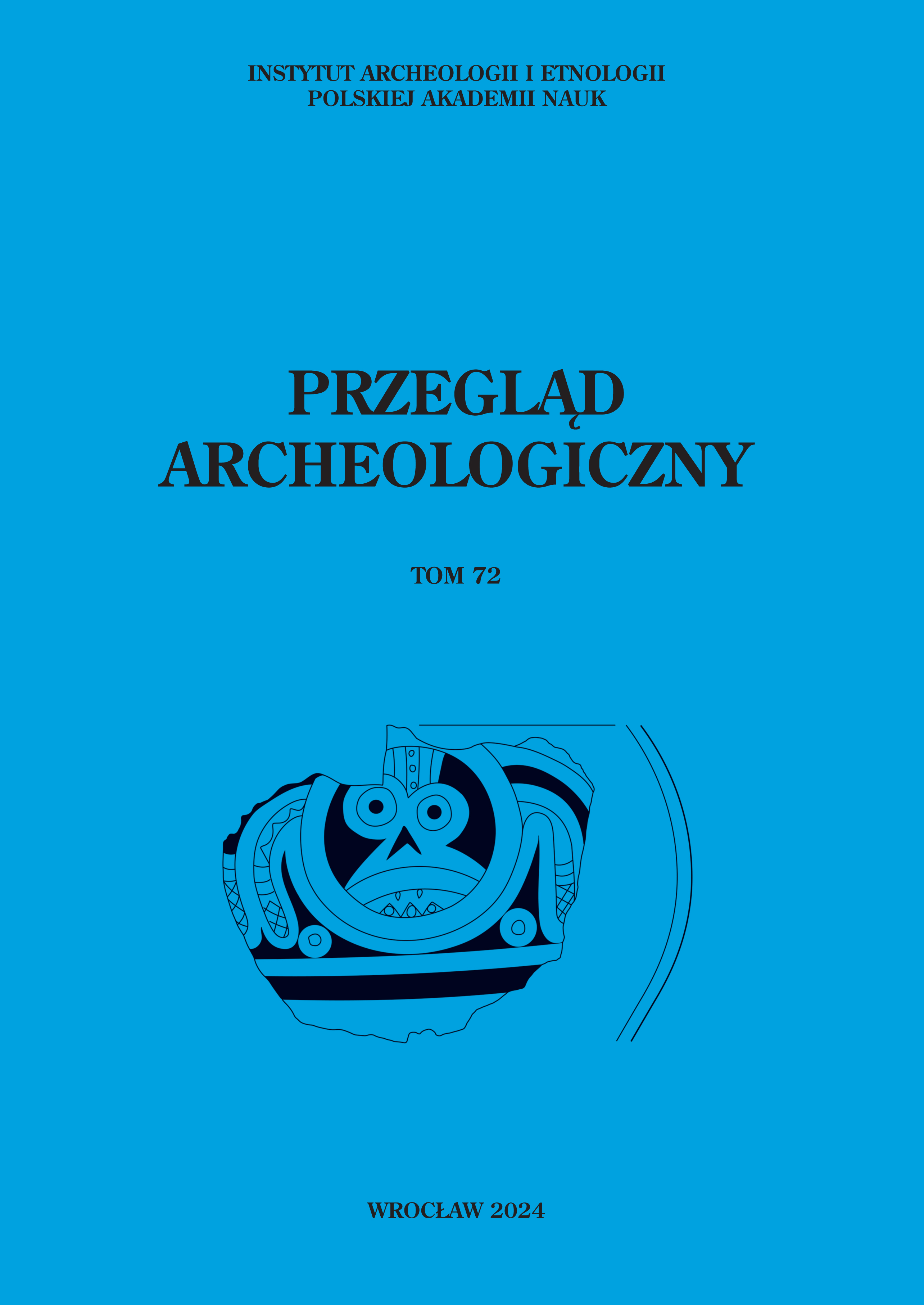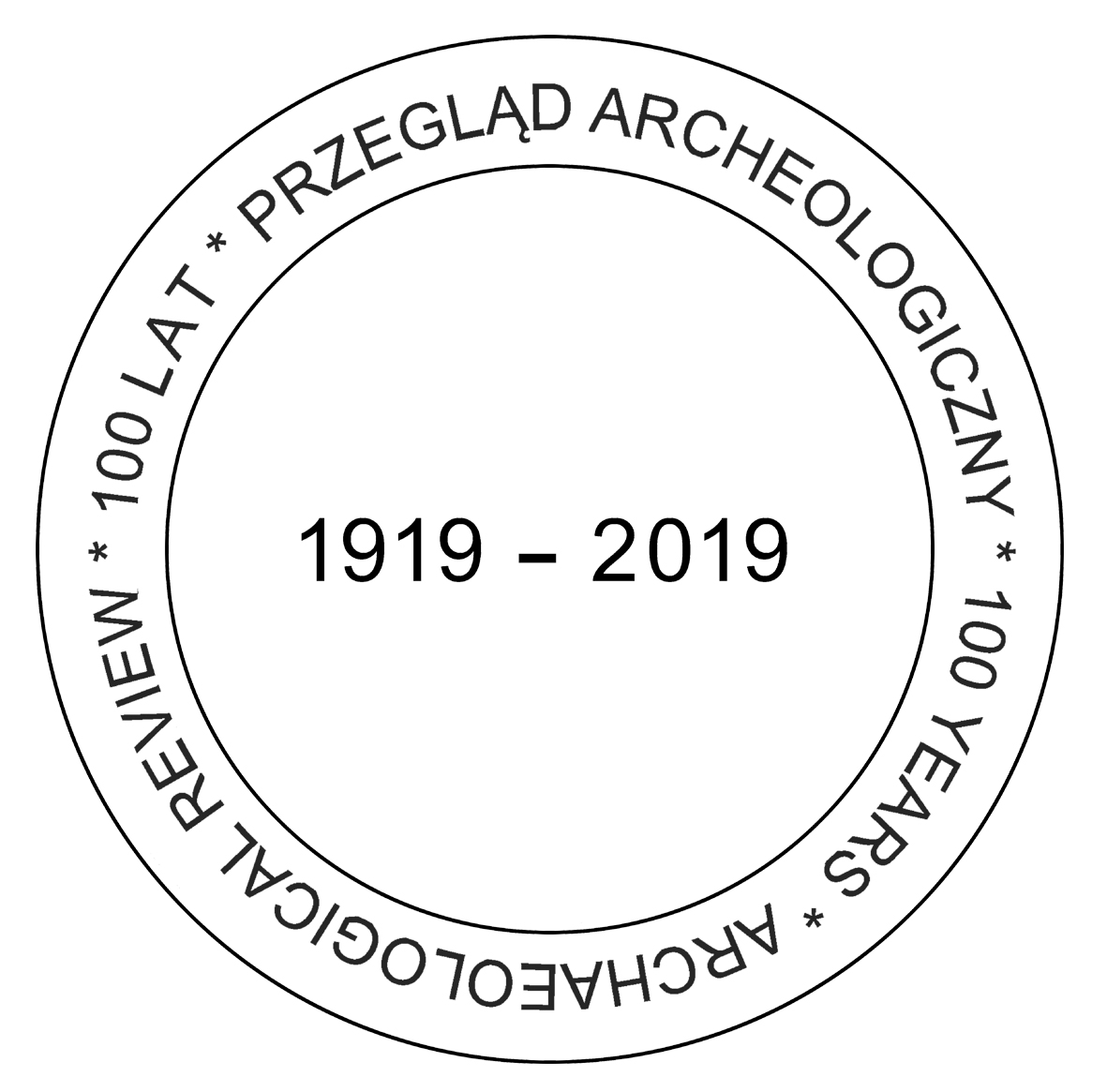Dekorowane naczynia z tykwy kultury Wari, Peru
DOI:
https://doi.org/10.23858/PA72.2024.3611Słowa kluczowe:
Wari, Castillo de Huarmey, mates pirograbados, Peru, gourd vessels, Middle Horizon, pre-Columbian art, iconographyAbstrakt
The subject of the present study is pre-Columbian pyro-engraved gourd vessels (mates pirograbados) discovered at Castillo de Huarmey – a necropolis of the Wari Empire elites located on the Pacific coast of present-day Peru. The iconographic analysis and further iconological interpretation of the ornamental motifs made it possible to identify distinctive native features and foreign influences indicating an intentional reference to earlier traditions, particularly evident in the depictions of supernatural beings. The entire iconographic system of the gourd vessels from Castillo de Huarmey is thus an expression of the imperial ideology drawing on traditions of sanctioning power previously known on the coast.
Pobrania
Bibliografia
Ahuja, S.D., Ahuja S., Ahuja U. (2011). Bottle Gourd – History, Uses, and Folklore. Asian Agri-History 15(4), 283–302.
Arguedas, J. M. (1957). Estudio Etnográfico de La Feria de Huancayo. Lima: Oficina Nacional de Planeamiento y Urbanismo.
Arriaga, P. J. (1621). Extirpación de La Idolatría Del Piru. Lima.
Benson, E. P. (2012). The Worlds of the Moche on the North Coast of Peru. Austin: University of Texas Press.
Beresford-Jones, D., Pullen A., Chauca G., Cadwallader L., García M., Salvatierra I., Whaley O. (2018). Refining the Maritime Foundations of Andean Civilization: How Plant Fiber Technology Drove Social Complexity During the Preceramic Period. The Journal of Archaeological Method and Theory 25, 393–425. DOI: https://doi.org/10.1007/s10816-017-9341-3
Bernier, H. (2010). Personal Adornments at Moche, North Coast of Peru. Ñawpa Pacha: Journal of Andean Archaeology 30(1), 91–114. DOI: https://doi.org/10.1179/naw.2010.30.1.91
Burger, R. L. (1992). Chavin and the Origins of Andean Civilization. London: Thames & Hudson.
Chicoine, D. (2011). Death and Religion in the Southern Moche Periphery: Funerary Practices at Huambacho, Nepeña Valley, Peru. Latin American Antiquity 22(4), 525–548. DOI: https://doi.org/10.7183/1045-6635.22.4.525
Chiou, K. L., Cook A. G., Hastorf C. A. (2013). Flotation versus Dry Sieving Archaeobotanical Remains: A Case History from the Middle Horizon Southern Coast of Peru. Journal of Field Archaeology 38(1), 38–53. DOI: https://doi.org/10.1179/0093469012Z.00000000035
Conlee, C. A. (2007). Decapitation and Rebirth: A Headless Burial from Nasca, Peru. Current Anthropology 48(3), 438–445. DOI: https://doi.org/10.1086/517591
Cook, A. G. (2012). The Coming of the Staff Deity. W: S. E. Bergh (red.), Wari: Lords of the Ancient Andes (103–121). New York:.Thames & Hudson.
DeLeonardis, L. (2000). The Body Context: Interpreting Early Nasca Decapitated Burials. Latin American Antiquity 11(4), 363–386. DOI: https://doi.org/10.2307/972002
Donnan, C. B. (1972). Moche-Huari Murals from Northern Peru. Archaeology 25(2), 85–95.
Donnan, C. B. (1976). Moche Art and Iconography. Los Angeles: UCLA Latin American Center.
Fernandini F. B., Ruales M. (2017). From the Domestic to the Formal: A View of Daily and Ceremonial Practices from Cerro de Oro during the Early Middle Horizon. W: S. A. Rosenfeld, S. L. Bautista (red.), Rituals of the Past. Prehispanic and Colonial Case Studies in Andean Archaeology, Colorado: University Press of Colorado. DOI: https://doi.org/10.5876/9781607325963.c008
Giersz M., Pardo C. (red.). (2014). Castillo de Huarmey. El mausoleo imperial wari. Lima: Museo de Arte de Lima.
Giersz M., Makowski K. (red.). (2016). Nuevas Perspectivas en la Organización Política Wari. Lima: Centro de Estudios Precolombinos de la Universidad de Varsovia.
Giersz M. (2017). Castillo de Huarmey: un centro del imperio wari en la costa norte del Perú. Lima: Ediciones del Hipocampo.
Giersz M., Prządka-Giersz P. (red.). (2018). Skarby Peru. Królewski grobowiec w Castillo de Huarmey. Warszawa.
González Ramírez, A. (2014). Las representaciones figurativas como materialidad social. Producción y uso de las cabezas clavas del sitio Chavín de Huántar, Perú. Barcelona: Universitat Autònoma de Barcelona.
Hart, John P., Daniels R. A., Sheviak C. J. (2004). Do Cucurbita Pepo Gourds Float Fishnets? American Antiquity 69(1), 141–148. DOI: https://doi.org/10.2307/4128352
Hudson, J. L. (2004). Additional Evidence for Gourd Floats on Fishing Nets. American Antiquity 69(3), 586–587. DOI: https://doi.org/10.2307/4128409
Isbell, W. H. (2008a). Wari and Tiwanaku: International Identities in the Central Andean Middle Horizon. W: H. Silverman, W. H. Isbell (red.), The Handbook of South American Archaeology (731–759). New York: Springer. DOI: https://doi.org/10.1007/978-0-387-74907-5_37
Isbell, W. H. (2008b). Ayacucho and the Staff God Pantheon: Wari, Tiwanaku, and the Late SAIS Era. W: W. H. Isbell, M. I. Uribe, A. Tiballi, E. P. Zegarra (red.), Images in Action. The Southern Andean Iconographic Series (423–478). Los Angeles: The Cotsen Institute of Archaeology Press.
Jiménez Borja, A. (1948). Mate Peruano. Revista Del Museo Nacional XVII.
Jiménez Borja, A., Colán Secas H. (1943). Mates Peruanos: Área de Huaral-Chancay, Departamento de Lima. Revista Del Museo Nacional XII.
Kałaska, M., Syczewski M., Kotowski J., Giersz M. (2020a). Chemical Composition of Small Fragments of Metals from Castillo de Huarmey (Peru): Chemical Analysis in the Micro‐Area Using FE‐SEM‐EDS, FE‐EMPA and XRD. Archaeometry 63(2), 372-397. DOI: https://doi.org/10.1111/arcm.12598
Kałaska, M., Druc I., Syczewski M., Siuda R., Makowski K., Giersz M. (2020b). Application of Electron Microprobe Analysis to Identify the Origin of Ancient Pottery Production from the Castillo de Huarmey, Peru. Archaeometry 62(6), 1095–1114. DOI: https://doi.org/10.1111/arcm.12581
Kan, M. (1972),.The Feline Motif in Northern Peru. W: E. P. Benson (red.), The Cult of the Feline. A Conference in Pre-Columbian Iconography (69–86).
Kanō, C. (1979). The Origins of the Chavín Culture. Studies in Pre-Columbian Art and Archaeology 22. Washington: Dubarton Oaks.
Knudson K.J., Giersz M., Więckowski W., Tomczyk W. (2017). Reconstructing the lives ofWari elites: Paleomobility and paleodiet at the archaeological site of Castillo de Huarmey, Peru. Journal of Archaeological Science: Reports 13, 249–264. DOI: https://doi.org/10.1016/j.jasrep.2017.03.047
Laszczka A., Splitstoser J. C., Giersz M. (2017). Pre-Columbian Textile Structures at Castillo de Huarmey, Peru. W: L. Bjerregaard, A. Peters (red.) PreColumbian Textile Conference VII / Jornadas de Textiles PreColombinos VII. Copenhagen. DOI: https://doi.org/10.13014/K26D5R59
Makowski, K. (2018). Huari, Tiahuanaco, and SAIS: The Local and the Foreign in the Iconography of the Empire. W: W. H. Isbell, M. I. Uribe, A. Tiballi, E. P. Zegarra (red.), Images in Action. The Southern Andean Iconographic Series (423–478). Los Angeles: The Cotsen Institute of Archaeology Press.
Masur, L., Blake M. (2018). Peanuts and Power in the Andes: The Social Archaeology of Plant Remains from the Virú Valley, Peru. Journal of Ethnobiology 38(4), 589–609. DOI: https://doi.org/10.2993/0278-0771-38.4.589
Parker, B. J., McCool W. (2015). Indices of Household Maize Beer Production in the Andes: An Ethnoarchaeological Investigation. Journal of Anthropological Research 71(3), 359–400. DOI: https://doi.org/10.3998/jar.0521004.0071.303
Piacenza, L. (2016). The Role of Plants in the Nasca Culture. W: R. Lasaponara, N. Masini, G. Orefici (red.), The Ancient Nasca World: New Insights from Science and Archaeology (101-119). Springer Link. doi.org/10.1007/978-3-319-47052-8. DOI: https://doi.org/10.1007/978-3-319-47052-8_6
Quilter, J. (1989). Life And Death At Paloma: Practices In Peruvian Village. Iowa: University of Iowa Press. DOI: https://doi.org/10.1353/book3549
Reiss, W., Stübel A. (1880). The Necropolis of Ancon in Peru: A Contribution to Our Knowledge of the Culture and Industries of the Empire of the Incas. Vol. 3. Berlin.
Ríos Acuña, S. (2019). Artesanías Del Perú: Historia, Tradición e Innovación. Lima: Ministerio de Comercio Exterior y Turismo MINCETUR.
Sabogal, J. (1945). Mates Burilados: Arte Vernacular Peruano. Lima.
Shady Solis, R. (2006). America’s First City? The Case of Late Archaic Caral. W: W. H. Isbell, H. Silverman (red.), Andean Archaeology 3: North and South (28–66). Boston: Springer. DOI: https://doi.org/10.1007/0-387-28940-2_3
Silva Martinot, J. L. (2012). Línea Artesanal de Mates Burilados - Tecnología e Innovación. Lambayeque: Ministerio de Comercio Exterior y Turismo MINCETUR.
Spahni, J.-C. (1969). Mates Decorados Del Perú. Lima.
Steele, P. R., Allen C. J. (2004). Handbook of Inca Mythology. Santa Barbara: ABC-CLIO. DOI: https://doi.org/10.5040/9798400661297
Stolberg, V. B. (2011). The Use of Coca: Prehistory, History, and Ethnography. Journal of Ethnicity in Substance Abuse 10, 126–146. DOI: https://doi.org/10.1080/15332640.2011.573310
Takigami, M. K., Shimada I., Segura R., Muno S., Matsuzaki H., Tokanai F., Kato K., Mukai H., Takayuki O., Yoneda M. (2014). Assessing the Chronology and Rewrapping of Funerary Bundles at the Prehispanic Religious Center of Pachacamac, Peru. Latin American Antiquity 25(3), 322–343. DOI: https://doi.org/10.7183/1045-6635.25.3.322
Tomczyk, W., Giersz M. (2017). Polydactyly suggesting local husbandry of Pre-Columbian camelids: Acase from Castillo de Huarmey archaeological site, northern coast of Peru. International Journal of Paleopathology 16, 40–43. DOI: https://doi.org/10.1016/j.ijpp.2016.11.003
Tomczyk, W., Giersz M., Sołtysiak A., Kamenov G., Krigbaum J. (2019). Patterns of camelid management in Wari Empire reconstructed using multiple stable isotope analysis: evidence from Castillo de Huarmey, northern coast of Peru. Archaeological and Anthropological Sciences 11, 1307–1324. DOI: https://doi.org/10.1007/s12520-017-0590-6
Trever, L., Gamboa J., Toribio R., Morales R., McEwan C. (2017). The Archaeology of Mural Painting at Pañamarca, Peru. Studies in Pre-Columbian Art and Archaeology 40. Washington: Dubarton Oaks.
Uhle, M. (1991). Pachacamac: A Reprint of the 1903 Edition. Philadephia: Museum of Archaeology and Anthropology, University of Pennsylvania.
Więckowski W. (2019). Wari Women from Huarmey. Oxford: Oxford University Press. DOI: https://doi.org/10.2307/j.ctvndv865
Wołoszyn J. Z. (2019). O rozlicznych pożytkach z tykwy. Przegląd Historyczny 110(4), 537-564. DOI: https://doi.org/10.36693/201904p.537-564
Verano, J. W., Uceda S., Chapdelaine C., Tello R., Paredes M. I., Pimentel V. (1999). Modified Human Skulls from the Urban Sector of the Pyramids of Moche, Northern Peru. Latin American Antiquity 10(1), 59–70. DOI: https://doi.org/10.2307/972211
Vergara Montero, E. (2015). Mates: Corpus Iconográfico Perú Prehispánico. Lima: Imprenta Gami.
Villegas Robles, R. (2001). Artesanía peruanas: historia viva. Lima: Universidad Ricardo Palma.
Pobrania
Opublikowane
Jak cytować
Numer
Dział
Licencja
Prawa autorskie (c) 2024 Przegląd Archeologiczny

Utwór dostępny jest na licencji Creative Commons Uznanie autorstwa 4.0 Międzynarodowe.















